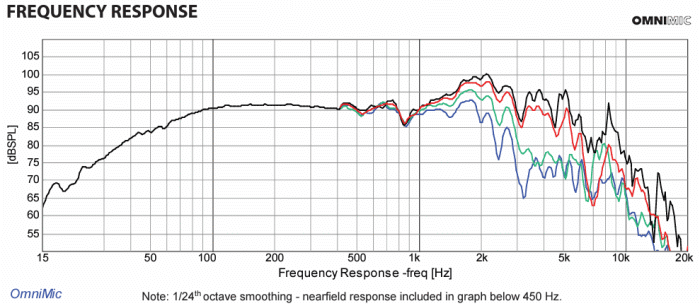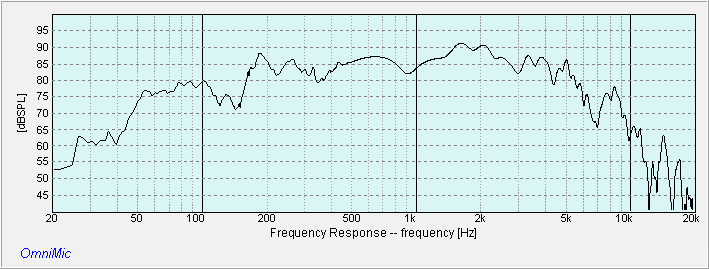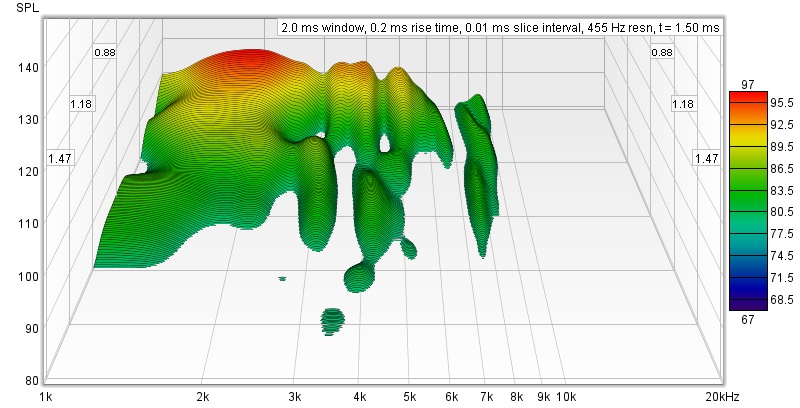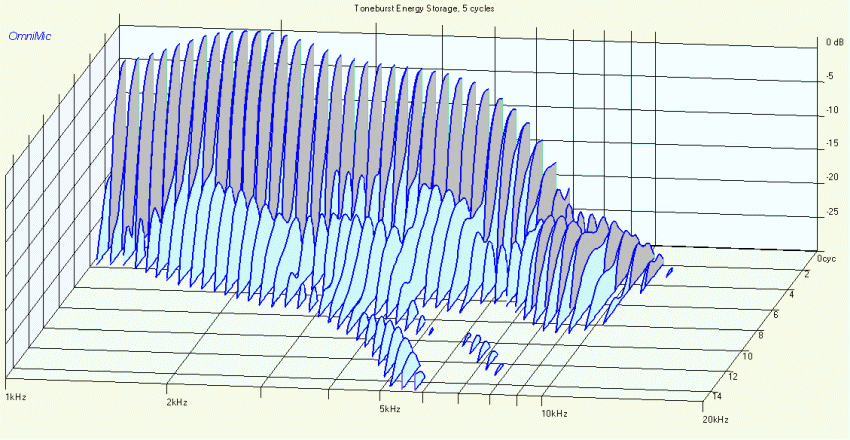|
GRS 10PT-8 Frequency Response (manufacturer) The plot above is from GRS’s datasheet. Note the notch at 850Hz. What comes after is a climbing response peaking at 2kHz which is where I believe the cone breakup occurs.
I had the GRS 10PT-8 mounted onto a 27 liters sealed box that I used in the Osprey-II. The result (Fig 1) is very similar to the manufacturer’s. The same notch appeared at 900Hz followed by a rising response peaking at 2kHz.
Fig 2 is the Waterfall plot of the 10PT-8. There are some artifacts but nothing serious.
The Toneburst plot (Fig 3) shows unwanted energy (light blue slices) from 1.5kHz ~ 5kHz.
The Spectrogram in Fig 4 is a 2D version of the Waterfall and Toneburst plots. Here, we can see the artifacts/unwanted energy emitting as green fumes. The two strong ones are at 1.1kHz and 1.6kHz. They don’t contain much energy because by 6msec, they are about 60dB below the fundamental. Above 2kHz, all the artifacts are dissipated by 2msec. What is interesting is at 6.5kHz. It appears there’s a dead zone lasting 0.5msec. This is where a deep notch at 7kHz is seen in Fig 1.
Strangely, the 10PT-8 recorded a better Step response compared to the Dayton MB1025-8 (Fig 5). The trailing edge doesn’t have the sharp peak that was seen in the MB1025. Instead a much milder peak is recorded later at about 600usec.
The Harmonic Distortion of the 10PT-8 (Fig 6) is lower than the MB1025-8. THD (H2-H9) is only 1.28% whereas the MB1025-8 lies at 3.72%. How much difference this makes when in use is left to be seen. Summary The GRS 10PT-8 cost only $29.90 at Parts Express but don’t let the price fool you. This is one woofer where cheap doesn’t equate with low quality. My measurements show that she is as good as other 10″ woofers costing twice as much. Sound wise, I cannot find any faults with the 10PT-8. There’s no boxiness in the voices which is a plus. Farther up, there is a slight emphasis at 2kHz. This will add some presence in the midrange. After 2kHz, the cone starts to breakup. When used in a 2-way, it means the horn cannot be crossed above 2kHz if one wants to preserve some measure of sound quality. The GRS 10PT-8 shines when used in a 3-way. Whether in pro use or HiFi, crossing at 200Hz~300Hz for bass will avoid the notch at 800Hz. A suitable enclosure is a bass reflex of 52 liters. This will result in a F3 of 47Hz. That should satisfy most music. Unless otherwise stated, all measurements were made in Full Space (4 pi) with the mic at 36 ins, tweeter axis. Impulse Window=5ms. No smoothing applied. |

September 8, 2023PRO DRIVERS

 Fig 1 – 10PT-8 Frq Response • Baffle Width = 14″
Fig 1 – 10PT-8 Frq Response • Baffle Width = 14″ Fig 2 – 10PT-8 Waterfall
Fig 2 – 10PT-8 Waterfall Fig 3 – 10PT-8 Toneburst Energy Storage
Fig 3 – 10PT-8 Toneburst Energy Storage

